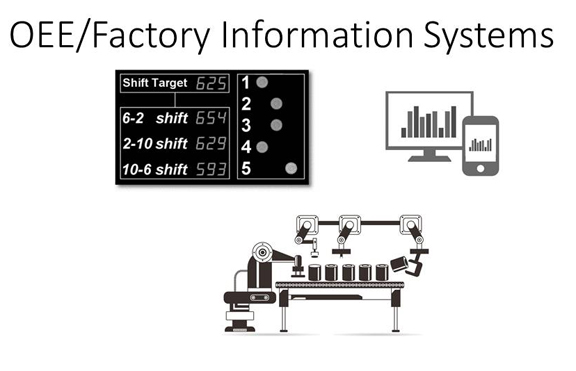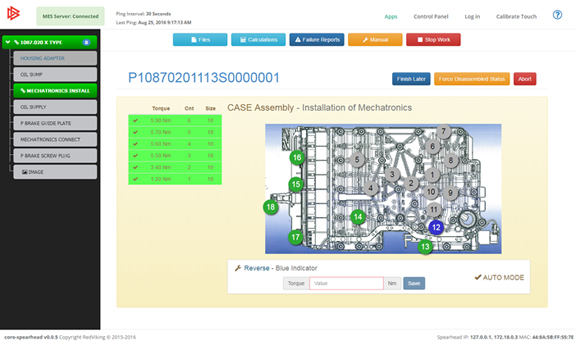RedViking Launches Argonaut MES at IMTS

Automated work instructions app from Red Viking’s Argonaut MES is a system that doesn’t require PCs.
September 15, 2016
 Red Viking’s Argonaut MES system, launched at IMTS this week, offers a series of apps, including one for overall equipment effectiveness and factory information system.
Red Viking’s Argonaut MES system, launched at IMTS this week, offers a series of apps, including one for overall equipment effectiveness and factory information system. Automated work instructions app from Red Viking’s Argonaut MES, powered by the company’s Spearhead hardware.
Automated work instructions app from Red Viking’s Argonaut MES, powered by the company’s Spearhead hardware.This week, Greg Giles, RedViking’s Executive Director of MES (manufacturing execution system), is in Chicago, Illinois. He’s attending the International Manufacturing Technology Show (IMTS), where the phrase industrial IoT (IIOT) echoes in the hallways and corridors.
“We see people collecting a lot more data,” he observed. “One of my customers said, ‘Man, I’m collecting lots of data. I don’t know what it’s for, but boy, do I have data!’ Collecting the information really doesn’t cost that much, and storage and computing power don’t cost that much anymore, so people want to collect the data even if they don’t know if they’ll need it.”
If data is what the customers want or need, RedViking is about to deliver it with its new offering, dubbed Argonaut. “Argonaut is the first fully configurable manufacturing performance platform,” the company writes. “Buy only the manufacturing apps you need, when you need them, and manage your entire enterprise from a central location.”
RedViking uses the term “apps” to signify a modular approach, which divides the MES tasks into a series of software-driven operations, such as OEE/FIS (overall equipment effectiveness and factory information system), Track & Trace, Error Proofing, IIoT Gateway, Automated Work Instructions, Kitting and Sequencing, and more. (The so-called apps are not designed for mobile devices.)
“We provide you with the ability to collect lots of data about the workflow through the Track and Trace app, data about equipment through the FIS (factory information system),” explained Giles. “So you can collect product- or machine-specific data. We house the data in MongoDB [ an open source databased system that counts Forbes, MetLife, and Facebook as its customers].”
Argonaut uses the company’s hardware units, dubbed Spearheads, to collect data. The Spearheads are installed in the factory and plant cells. They’re available for purchase as well as rental. Typically, the dual-network interface of the unit is connected to the plant floor PLC (programmable logic controller) at one end, to the network at the other.
“A lot of the manufacturers use PC-based solutions,” Giles observed. “They tend to require a lot of IT support” PCs introduce some security risks and additional maintenance burdens, he warned. “The plant managers have to lock down the PCs when not operating so the hardware cannot be used in unintended ways. When they need to issue software updates or change the configuration, they often have to go onsite to access the physical PCs.”
A typical consumer-grade PC would cost between $450 to $1,200, based on processor speed and storage. A Spearhead unit, Giles said, “costs somewhere in the neighborhood of $300.” He also pointed out, “Our hardware is not Windows-based, so you don’t have to pay for Windows licenses or antivirus software, or worry about OS updates.”
The Argonaut apps are managed from a central location. Therefore, as long as the units are installed in the desired cells, a plant floor manager could reconfigure the series of apps running on the Spearheads. Giles said, “With Argonaut, we allow these updates and configurations to be done from the server. Users can specify which software, which specific configuration the users on the floor should run.”
For customers with robust PLM systems, Argonaut can also be integrated with their existing frameworks. Giles noted, “Some of our customers don’t have sophisticated PLM setups, so, in that case, the MES can pull the data, like the latest work instructions, from a network drive. But for customers in advanced manufacturing with proper PLM systems, we support integration.”
The explosion of data is expected to create the need for data analytics. Many IoT experts believe the volume of data may become too vast for consumption and comprehension. Hence, the need for algorithm-driven AI-like analytical tools. (For more listen to DE webcast titled “Don’t Drown in Data,” now available on-demand.)
Giles said, “We don’t currently have plans to add data analytics. We are talking to third-party vendors and system integrators to work with us. It’s on our road map.”
One quick-and-dirty method to manage industrial IoT data might be to selectively expose useful data streams and hide the rest, Giles suggested. “It might be worthwhile to collect the additional data, because in the future, when you do get data analytics, you can use the data to, for example, predict failures. But if you don’t have the data, you can’t feed it into the system for analysis.
Subscribe to our FREE magazine, FREE email newsletters or both!
About the Author
Kenneth Wong is Digital Engineering’s resident blogger and senior editor. Email him at [email protected] or share your thoughts on this article at digitaleng.news/facebook.
Follow DE





